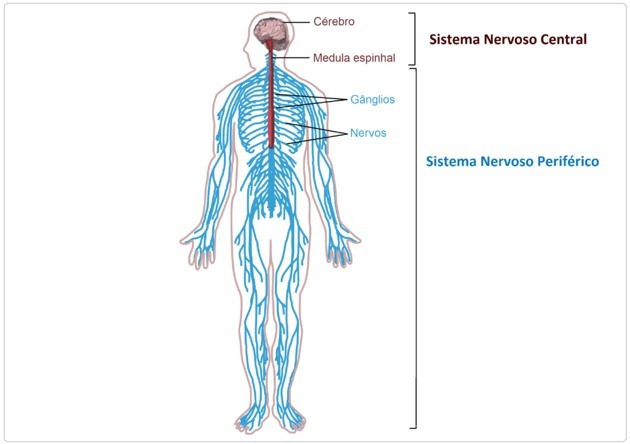The Peripheral Nervous System (PNS) is formed by the nerves and nerve ganglia.
Its function is to connect the Central Nervous System to the other organs of the body and thus carry out the transport of information.
It is one of the divisions of the Nervous System, which anatomically is divided into:
- Central Nervous System (CNS): brain and spinal cord;
- Peripheral Nervous System (SNP): nerves and nerve ganglia that connect the CNS to the organs of the body.
Peripheral Nervous System Components

The SNP is made up of nerves and ganglia. They are responsible for connecting the CNS to the parts of the body.
See below how each of these components works in the human body.
nerves
You nerves they correspond to bundles of nerve fibers surrounded by connective tissue. They are responsible for joining the CNS to other peripheral organs and for transmitting nerve impulses.
Nerves have the following division:
- Spinal Nerves: composed of 31 pairs, they are the ones that connect with the spinal cord. These nerves are responsible for innervating the trunk, limbs and some specific regions of the head.
- Cranial Nerves: composed of 12 pairs, they are the ones that connect to the brain. It is these nerves that innervate the structures of the head and neck.
Nerves have the following types:
- Afferent (Sensitive) Nerves: send signals from the periphery of the body to the central nervous system. This type of nerve is capable of capturing stimuli such as heat and light, for example.
- Efferent Nerves (Motors): send signals from the central nervous system to the muscles or glands.
- mixed nerves: formed by sensory fibers and motor fibers, for example, the spinal nerves.
Know more about:
- nervous impulse
- cranial nerves
- nerve tissue
nodes
Nerve ganglia are clusters of neurons located outside the central nervous system, scattered throughout the body. It is common for them to form a spherical structure.
See the image below for a summary map of the components of the Peripheral Nervous System.

Learn more, read also:
- Nervous system
- Central Nervous System
Divisions of the Peripheral Nervous System

The SNP is divided into the somatic nervous system and the autonomic nervous system, according to its role.
- Somatic Nervous System: regulates actions that are under the control of our will, that is, voluntary actions. It acts on the skeletal musculature of voluntary contraction.
- Autonomic Nervous System: acts in an integrated way with the central nervous system. Generally, it controls activities that are independent of our will, that is, involuntary actions such as activities carried out by internal bodies. Acts on smooth and cardiac muscles
The Autonomous Nervous System has the function of regulating organic activities, ensuring the organism's homeostasis. It has two subdivisions:
- Sympathetic Nervous System that stimulates the functioning of the organs; it is formed by the spinal nerves in the thoracic and lumbar region of the cord. The main neurotransmitters released are norepinephrine and epinephrine.
- Parasympathetic Nervous System that inhibits the functioning of the organs; it is formed by the cranial and spinal nerves at the ends of the cord. The main neurotransmitter released is acetylcholine.
See the image below for a summary map of the Peripheral Nervous System division.

Expand your study and also read:
- Neurotransmitters
- Exercises on the Nervous System


